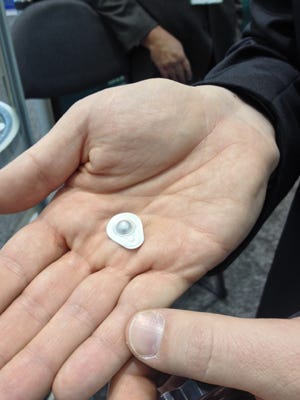April 3, 2014
J-Pac Medical in recent years has found that its medical device packaging know-how has been useful when it comes to finding solutions in the diagnostic market.
|
Every time someone presses the blister, the reagent leaves at a precise point. |
The whole idea is to create point-of-care devices that can quickly test saliva, urine, or blood samples in an error-free manner, helping health providers catch dangerous infections and pathogens early in patients.
With Obamacare pushing U.S. health providers to have patient populations play a more active role in managing their own health and save the system money, demand is growing for such diagnostics--including tests patients might use themselves at home, says Jeffrey Koslosky, J-Pac's vice president of marketing and business development, and Stephen Sousa, J-Pac's business development director.
Koslosky and Sousa spokes with MPMN last week on the trade floor of BIOMEDevice Boston.
To help achieve easy-to-use testing devices, J-Pac turned packaging technology on it head when it comes to the aluminum-polymer blisters containing reagents on testing cards.
When sealing packaging, the goal is often to apply uniform heat in order to achieve a uniform seal, Koslosky explained.
But that wasn't J-Pac's goal with the reagent blisters. "We're intentionally creating something that will fail at a particular area, a localized region, under a specific pressure," Koslosky said.
Every time someone presses the blister, the reagent leaves at a precise point.
"It would go through a series of channels that are etched into this card, mix with the test sample and give the user instantaneous feedback on what the result of the test is. These can be done with blood, with saliva, with urine," Koslosky said.
Koslosky describes it as "packaging but elevated to a little bit of a different level."
"That steering, that control--there's science behind that application of heat," Koslosky said.
Check out more packaging and sterilization technology on the floor at MD&M East, June 9-12, 2014 in New York City. |
"It's the next generation for us in terms of packaging," Sousa said. He suspects such tests will also improve patient health and save the U.S. health system money.
See Richard Crane, vice president of J-Pac's innovation services group, explain the blister technology in an MPMN video from the Boston trade floor:
The blister technology is an example of how suppliers such as J-Pac are becoming more creative.
"A lot more of those processes are being outsourced from a design standpoint. Everything from early stage design to delivery of the finished product is being pushed to suppliers like J-Pac Medical," Koslosky said. "It is essential to develop a strong collaboration between product development and contract packaging teams early in the design process, as a failure to share even the smallest details can result in costly delays in terms of both time and cost."
J-Pac is also active in the sterilization services space, where Sousa notices more customers switching back to ethylene oxide (EtO) sterilization, versus gamma radiation. Sousa suspect part of the trend might be related to medical device companies trying out different polymers: "Most of the stuff out there still isn't gamma compatible, so they're still going with EtO."
Chris Newmarker is senior editor of MPMN and Qmed. Follow him on Twitter at @newmarker.
About the Author(s)
You May Also Like



